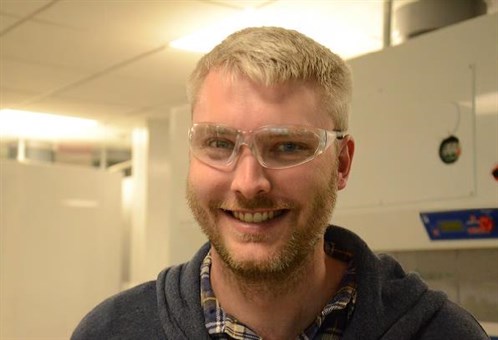New chemistry transforms cancer vaccine (2013)
A new kind of chemistry that dramatically simplifies the manufacture of cancer vaccines was created this year by Honours student Tom Wright.
 In 2013, immune therapy for cancer was a very hot topic in cancer medicine. The first clinical trials showing immune therapy could benefit large numbers of patients have led to predictions that immune therapy will eventually become routine for cancer patients.
In 2013, immune therapy for cancer was a very hot topic in cancer medicine. The first clinical trials showing immune therapy could benefit large numbers of patients have led to predictions that immune therapy will eventually become routine for cancer patients.
As part of its immune therapy programme, the MWC, with support from the Health Research Council, has been developing new vaccines for cancer patients that aim to stimulate the immune system to attack cancer cells. These vaccine molecules are made in a modular system. Molecules that stimulate the immune system are “clicked” together with molecules that mimic those found in cancer cells. When these combined molecules are injected they stimulate immune cells to seek out and destroy cancer cells bearing the molecule that was in the vaccine.
MWC investigator Professor Margaret Brimble supervised Tom Wright’s research project in the School of Chemical Sciences at the University of Auckland. “In this project we were thinking about translation of our work to patients up front – molecules we’d be able to manufacture ourselves for use in clinical trials,” she says. “Tom developed a simple and elegant new method for joining the immune stimulant with the cancer molecule. And the very simplicity of the method makes it much easier to manufacture the molecules safely for clinical trials. Tom came up with a very clever solution to the challenge.”
The work may soon be used in the clinic, as the University of Auckland’s peptide chemistry laboratory now has a dedicated facility to manufacture cancer vaccines at a standard suitable for clinical trials. “We’re now looking at different molecules to target in different cancers, and also at improving the technology for further gains, in both effectiveness and ease of manufacture,” Margaret says .
The initial work has already been published in Angewandte Chemie, one of the most prestigious journals in the field of chemistry. It has also led to the filing of a patent that will enable the technology to be taken to clinical trials.
Biological testing of the new molecules took place in the laboratory of MWC Director Professor Rod Dunbar. MWC Research Fellow Dr Anna Brooks developed new methods to test the compounds using human blood samples, which provided an immediate indication of the human immune response to these molecules. Tom worked with Anna and Dr Julie Macintosh to carry out many of the biological tests, learning practical biology as part of an inter-disciplinary project.
Tom is now in Oxford after winning a highly competitive Rutherford Foundation scholarship to fund his doctoral studies in chemistry. After such an outstanding start to his career, the MWC is understandably very keen to attract him back, following what will undoubtedly be a highly successful sojourn in the UK.
Feature image: Honours student Tom Wright.
Image courtesy of Pauline Curtis